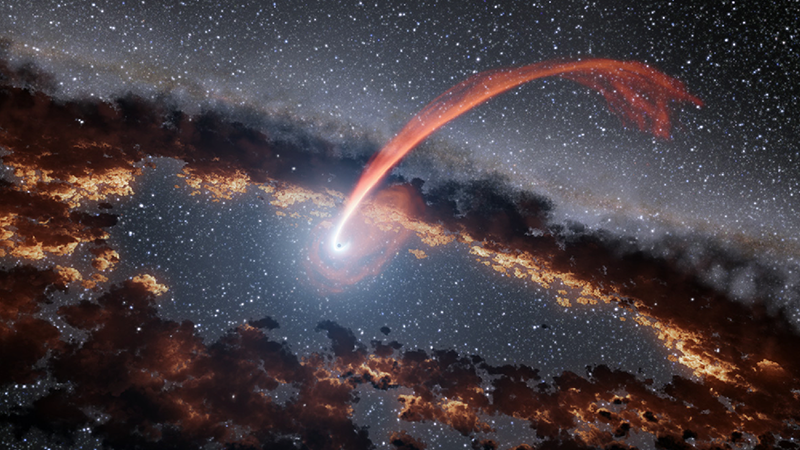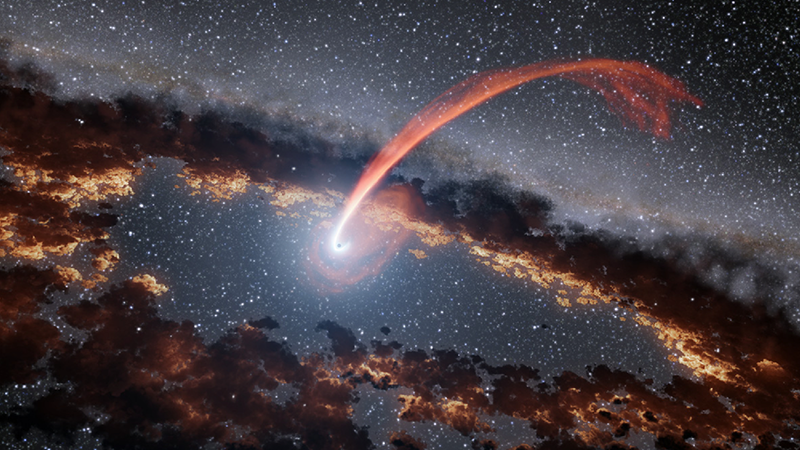“Revolution” for Alternative Black Hole Probe
A star that drifts too close to the supermassive black hole at the center of its galaxy can be torn into streams of gas that radiate as brightly as a supernova as they fall toward the black hole. These so-called tidal disruption events (TDEs) can provide a rare probe of supermassive black holes (SMBHs) and potentially help answer some long-standing astrophysical questions. In the past 25 years, only about 20 TDE’s have been documented, but that number is about to double. “We’re in the middle of a revolution” of TDE observation, said astronomer Sjoert van Velzen of New York University in a presentation at the APS Virtual April Meeting. Van Velzen said that the upcoming abundance of observations will allow researchers to address such questions as whether small-mass galaxies contain SMBHs and the nature of the black hole event horizon.
SMBHs can weigh as much as a few billion Suns, and astrophysicists believe that one resides at the center of every large galaxy. As the galaxy size decreases, the SMBH mass decreases as well, and SMBHs also appear in medium-sized galaxies. But whether this trend extends to “dwarf” galaxies is unclear. These galaxies would harbor black holes weighing less than about a million solar masses, a size that pushes the resolution limits of observations.
SMBHs are thought to play an essential role in galaxy evolution, so an accurate SMBH “census”—including the smallest galaxies, which are the most numerous ones—is critical for evaluating galaxy formation models. For example, according to “direct collapse” models, in the early Universe, larger gas clouds at the centers of galaxies could collapse to form SMBHs, but not smaller ones. These models predict that small galaxies would be unlikely to host SMBHs today.
As it turns out, TDEs are more common in smaller galaxies, partly because these galaxies have a higher density of stars in their central regions than larger galaxies. So observing enough TDEs could provide a population count of low-mass SMBHs. At the other extreme, counting TDEs from high-mass SMBHs would also be useful. SMBHs larger than about 100 million solar masses are predicted to have an event-horizon radius larger than their tidal-disruption radius, so these behemoths simply swallow stars whole, without any disruption event. The precise SMBH mass where TDEs become impossible depends on the SMBH’s rotation rate, or “spin,” so with enough TDE observations, researchers could learn about the typical SMBH spin and test predictions of general relativity and of galaxy formation models.
Using the Zwicky Transient Facility on Mt. Palomar in California, van Velzen and his colleagues have identified 17 TDEs over the past year and half, which nearly doubles the number recorded since the first TDE identification in 1996. Other collaborations have also been chalking up new TDEs lately. Van Velzen said his soon-to-be-published data on the 17 events contain several surprises, such as a correlation between the age of the stars in a galaxy and the spectrum of the TDE. “It’s amazing that we can potentially see this [correlation] in the data,” he said, given that the characterization of the stars is based on the spectrum of the entire galaxy, whereas the TDE represents a single star.
This burst of TDE observations is “tremendously exciting,” said Michael Kesden, of the University of Texas at Dallas, who spoke about TDEs at a different session at the meeting. He said the increase is partly a byproduct of the surge in surveys and telescopes dedicated to supernova discovery that have come online over the past 20 years, as cosmologists have used supernovae to measure the expansion of the Universe. Supernova detections require repeated observations of the same patch of sky, to see what changes from day to day—an approach called time-domain astronomy—exactly what TDE discoveries require. “Advances in time-domain astronomy may lead to the discovery of thousands of TDEs over the next five years,” said Kesden, enough to address questions about SMBHs at both low and high masses.
Even with far fewer detections, van Velzen and his colleagues may have bagged a big result. In a paper that has not yet been peer reviewed, the researchers report that one of their recently discovered TDEs was coincident on the sky with a 1015-eV neutrino detected by the IceCube facility in Antarctica. The team’s calculations find that the probability of the neutrino appearing by chance is less than 1%. This event would be one of only a handful in which a detected high-energy neutrino has been associated with a specific source observed by other means. Since the sources of such cosmic neutrinos are mostly unknown, this hint that TDEs emit neutrinos could be important for both neutrino and TDE astrophysics.
–David Ehrenstein
David Ehrenstein is the Focus Editor for Physics.





